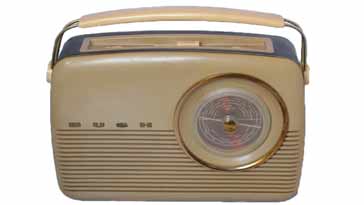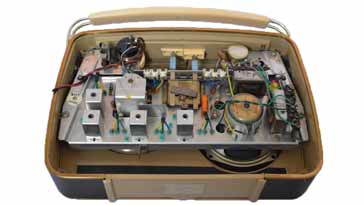Bush TR82 Vintage Portable Transistor Radio
The Bush TR82 is a classic early transistor portable radio with a distinctive design which has been copied by many modern radios wanting a vintage look.
Bush Radios Includes:
Bush DAC90A
Bush TR82 transistor portable
Iconic radio receivers:
Summary of iconic radio receivers
Radio receiver history
Crystal radio sets
Development of the superhet radio
Radio history / timeline
The Bush TR82 vintage transistor portable radio was first manufactured and became very popular. It's style almost became synonymous with a transistor portable in the early 1960s.
The radio was manufactured by the Bush Radio Company which had previously produced valve based favourites including the DA90 and DAC90A of the 1940s.
The TR82 became very popular with teenagers and young people because it was portable and with people having increasing amounts of cash after the war, it sold very well.

Bush TR82 history
With transistor technology just starting to be included domestic products a few radios started to incorporate this technology.
The very first domestic broadcast transistor radio was launched in 1954, but in order to keep its costs down, the circuit was simplified and performance was not particularly good.
In view of the costs of early transistors and their inferior performance to valve / tube technology, it took some while for transistor radios to reach the domestic market.
Bush had been a manufacturer of some very successful radios for the domestic markets. The DAC90A was one such example.
However int he 1950s there was a growing demand for portable radios. Some low heater current and lower HT voltage valves were developed to help address this growing market, but radios still needed to use high voltage batteries (90V) as well as more powerful batteries fort he heaters.
Responding to the need for portable radios, Bush initially produced a portable radio using these valves. Called the MB60 (MB for Mains/Battery) it was launched in 1957 was was successful.
One of the key elements of the design was the very stylish case designed by David Ogle.
However the long term goal was for a transistor radio. In 1959, the TR82 was launched. In many ways this was a transistorised version of the MB60 as it had the same case style as the MB60.
The TR82 was far more convenient to use than the MB60 as it only required a single PP9 battery and this lasted very much longer than the batteries required for the valve radios.
The initial radios launched were the TR82B and TR82C - the only difference between them was the colour scheme. The cost was £17 8s 11d which was quite expensive for the day, but they represented a very good radio.
Bush TR82 specifications
Considering the Bush TR82 was one of the earlier radios to adopt transistor technology, it worked very well and many are in use today.
| Brief Specification for the Bush TR82 Broadcast Radio |
|
|---|---|
| Parameter | Specification |
| Basic description | Early transistorised portable radio using superheterodyne techniques for use on the long and medium wave bands. |
| Wavebands | Long wave: 158 to 280 kHz |
| Controls | Tuning, Volume, tone control, push button waveband selection |
| Battery required | PP9 / |
| Loudspeaker | 5 inch (12.7cm) |
| Dimensions | 13.5 x 10.75 x 3.75 inch (34.3 x 27.3 x 9.5 cm) |
Bush TR82 Models
A number of different TR82 variants and models became available and these were designated by a suffix on the basic model number.
A summary of the different models is given in the table below.
| Bush TR82 Models & Variants |
|
|---|---|
| Type number | Details |
| TR82B | Case colour of "Regency Cream" and brown Rexine band around the case. Trim was brass, although described by the manufacturer as "Florentine Bronze." First available 1959 using the A177 chassis / electronics. |
| TR82C | Case colour was blue / green with a blue Rexine trim around the case and a chrome trim. First available 1959 using the A177 chassis / electronics. |
| TR82D | Case colour was light cream with a tan Rexine trim around the case and a chrome trim. First available 1962 using the A177 modified chassis / electronics. |
| TR82CL | Case colour was blue / green with a blue Rexine trim around the case and a chrome trim. First available 1964 using the A458 chassis / electronics. One of the key elements of the "L" version was the button to provide direct reception of Radio Luxembourg which was very popular at the time. |
| TR82DL | Case colour was light cream with a tan Rexine trim around the case and a chrome trim. First available 1964 using the A458 modified chassis / electronics. One of the key elements of the "L" version was the button to provide direct reception of Radio Luxembourg which was very popular at the time. |
Bush TR82 circuit description
The circuit for the TR82 contained a total of severn transistors and one diode.

The radio also used a ferrite rod antenna making reception possible without the need for an external antenna, although there was a socket for one if required.
RF input: The signals are picked up by a ferrite rod antenna which has resonant windings for the long and medium wave bands. Tuning is provided by a variable capacitor which is ganged with re local oscillator resonant circuit.
The signal is taken from the ferrite rod by a step down winding (one for each band) and taken to the first transistor TR1.
A further winding on the ferrite rod provides linking for an external antenna.
•RF and Mixer stage: The RF input, mixer, local oscillator and output to the IF is provided by the first transistor, TR1. The oscillator coil has three windings: one of the emitter circuit, one of the collector circuit and the third provides the resonant winding which is tuned by the variable capacitor which is ganged with that at the input so that both RF input and local oscillator track together.
The linking between the emitter and collector provides the required feedback to cause oscillation.
The collector circuit also has an IF transformer to provide filtering of the required signals and coupling to the IF stage.
•IF stage: The IF stage of the TR82 circuit contains two transistors, TR2 and TR3 to provide a high level of gain. The collector circuits of both transistors have IF transformers to provide coupling to the ext stage as well as selectivity.
•AM detector: A single diode is used to demodulate the AM signal. This is used to provide the audio for the later stages as well as the AGC which is applied using a longer time constant filter to remove the modulation and only see the overall signal level. This is applied to the first IF stage.
•Audio stages: The audio stages utilise four transistors. The first two, TR4 and then TR5, provide successive amplification. The output from TR5 is applied to an audio transformer to enable driving of the push pull output circuit.
The two transistors in the output take opposite sides of the waveform and as a transformer is used, both transistors can be PNP varieties. The same type of transistor s used for both elements.
The output from the push pull output is again applied to an output audio transformer for the combination of both halves of the waveform. This transformer also provides matching to the loudspeaker.
The transistor types were varied during the course of production and for the different boards.| Bush TR82 Transistor Line-Up A177 Board |
|||
|---|---|---|---|
| Transistor ident | Version 1 | Version 2 | Version 3 |
| TR1 | OC44 | OC44 | OC44 |
| TR2 | OC45 | OC45 | OC45 |
| TR3 | OC45 | OC45 | OC45 |
| TR4 | OC72 | OC71 | OC72 |
| TR5 | OC72 | OC78D | OC81 |
| TR6 | OC72 | OC78 | OC81 |
| TR7 | OC72 | OC78 | OC81 |
| D1 | OA70 | OA70 | OA70 |
For the later production models, new transistors with better performance had become available, and these were used in many of the positions.
| Bush TR82 Transistor Line-Up A458 Board |
|
|---|---|
| Transistor ident | Version 1 |
| TR1 | AF117 |
| TR2 | AF117 |
| TR3 | AF117 |
| TR4 | OC71 |
| TR5 | OC81D |
| TR6 | OC81 | /tr>
| TR7 | OC81 |
| D1 | OA90 |
It is worth noting that the AF117 commonly developed a short circuit and stopped working after many years. If the set does not work, this is worth investigating.
The Bush TR82 is one of the iconic vintage radio receivers. Initially produced in 1959 after the MB80, the styling of these radios meant that became synonymous with a portable radio of the time.
Nowadays these radios are often seen on the vintage radio markets and on the Internet, but because of their iconic design, the do attract a premium for anyone wanting to buy one.
 Written by Ian Poole .
Written by Ian Poole .
Experienced electronics engineer and author.
More History:
Radio history timeline
History of the radio
Ham radio history
Coherer
Crystal radio
Magnetic detector
Spark transmitter
Morse telegraph
Valve / tube history
PN junction diode invention
Transistor
Integrated circuit
Quartz crystals
Classic radios
Mobile telecoms history
Vintage mobile phones
Return to History menu . . .




